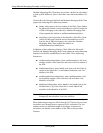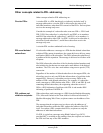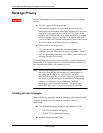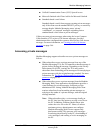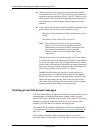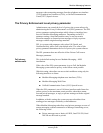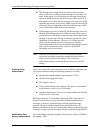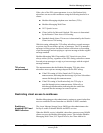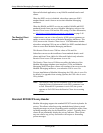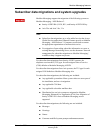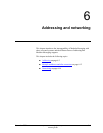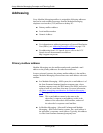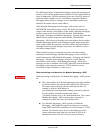
Avaya Modular Messaging Concepts and Planning Guide
5-48 November 2004
Avaya Modular Messaging Concepts and
Planning Guide
Microsoft Outlook application, or any IMAP4 standard-based e-mail
clients.
When the POP3 service is disabled, subscribers cannot use POP3
standard-based e-mail clients to access their Modular Messaging
mailboxes.
When the IMAP4 and POP3 services are enabled, IMAP4 and POP3
standards-based clients can access Modular Messaging, subject to the
Restrict Client Access COS and the PEL setting. For more information,
see The Privacy Enforcement Level privacy parameter
on page 5-45.
The Restrict Client
Access COS
Administrators can use a class-of-service (COS) privacy parameter to
enable or restrict client access to Modular Messaging mailboxes. This
COS, known as the ‘Restrict Client Access’ COS determines whether
subscribers using that COS can use an IMAP4 or POP3 standards-based
client to access their Modular Messaging mailboxes.
This Restrict Client Access COS has values of Yes and No.
Subscribers can access their mailboxes from standards-based e-mail
clients and from Client Add-in for Microsoft Outlook only when the
Restrict Client Access COS parameter is set to No.
The Restrict Client Access COS does not affect the behavior of the
Modular Messaging telephone user interfaces (TUIs) and Modular
Messaging Web Client; these clients will continue to have access to the
Modular Messaging mailboxes, even when the COS is set to Yes.
For new installations of Modular Messaging, the COS value is set to Yes
by default. For upgrades from existing systems, the COS value is set to
No by default.
Note: The Restrict Client Access to Mailbox COS is not relevant
when the Privacy Enforcement Levels (PEL) parameter is set
to Full. When the PEL parameter is set to Full, the system
operates as if all COS have the Restrict Client Access setting
of Yes.
Standard RFC822 Privacy Header
Modular Messaging supports the standard RFC822 sensitivity header for
privacy. This allows subscribers using standards-based clients to mark
outgoing messages as private. Depending on the capabilities of the client,
incoming messages may also be identified as ‘private’. Typically, these
clients do not prominently display the privacy indicator. These clients
may not enforce any privacy restrictions with respect to forwarding
private messages.



